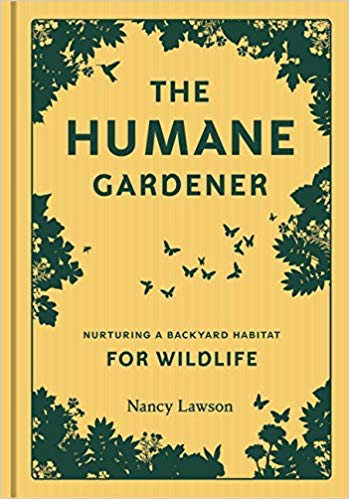What in the world could be inhumane about gardening?
Plenty, it turns out, thanks to this beautifully produced and incredibly important book by Nancy Lawson: The Humane Gardener: Nurturing a Backyard Habitat for Wildlife.
The Humane Gardener makes a persuasive case for rethinking conventional knowledge about what a garden or yard should look like and how we should care for it. That is, maybe we should stop using chemicals and other artificial pesticides, start supporting native and pollinator-friendly plants, and start letting nature do its own thing. Lawson rightfully blames the critter industrial complex for fostering an adversarial relationship between humans and specific non-human animals such as deer, raccoons, and any number of insects that we may not even realize are actually trying to eat the insects eating our vegetables.
But there is more to it I think. We were raised to view our gardens and lawns as exterior versions of our homes: orderly, clean, and something we visibly control. But truly organic and native gardening and agriculture requires embracing a bit of mess, a bit of chaos. And that’s okay. What we see as disorder and chaos is often nature doing what it does best.
Lawson includes a half-dozen profiles of gardeners across the US, along with photos, which provides a range of inspirations for how we might work with our yards. I love the profile of Charlotte Adelman — a retired lawyer based in Illinois who fights for wildlife of all species. She even successfully banned leaf blowers in her town — an inspiration to us all! My platform for my imagined mayoral run will be built on banning these vile instruments of torture.
Lawson challenges many gardening conventions, challenging us to rethink how we relate to our plants and animal neighbors. Here are a few conventions she challenges:
- That all weeds are horrible and must be pulled, such as dandelions (I’ve allocated a large section of yard to letting dandelions do their thing. I have come view them as one of the easiest pollinator gardens to grow. They bloom early in the season, which is hugely important to bees who are desperate for nutrition in these early days.)
- That leaves must be raked up like yesterday’s trash. Leaves are nature’s mulch. They help soil retain water and they provide much-needed organic matter. Try letting them be, despite your urge to clean them up (I have battled that urge myself). I know a gardener who asks neighbors to give her their leaves instead of bagging them so she can use them for her extensive vegetable gardens. Leaves are a terrible thing to waste.
- That many perennial plants and shrubs must be dead-headed at the end of the summer. Let those bare branches be. They can provide shelter to animals and they also help the plants survive tough winters.
Lawson lives on the East Coast, so I did find some of her plant recommendations a bit out of my “zone” here in the inland “Mediterranean” climate of Southern Oregon. But a few of her profiles include gardeners in the western half of the country, particularly a wonderful story of a San Diego gardener who transformed his property into an environmental reserve.
On a much larger level, this book is about setting things right with the world. The chemicals and other pollutants we have dispersed over the past hundred years have exacted a toll on nature, a bill that is coming due in the form of mass extinction and climate change. Yes, this is hugely depressing, but not hopeless. Every yard, every square foot of ground, presents an opportunity for us to make a difference for animals and for the planet. It adds up. And it feels good to know you’re doing good.
I highly recommend this book to any and all gardeners. It might challenge your assumptions about what constitutes a “pest,” but what is gardening without challenges?

The Humane Gardener
Princeton Architectural Press
John is co-author, with Midge Raymond, of the Tasmanian mystery Devils Island. He is also author of the novels The Tourist Trail and Where Oceans Hide Their Dead. Co-founder of Ashland Creek Press and editor of Writing for Animals (also now a writing program).

